Santa Barbara and the Sea Otter
As Species Creeps Past Point Conception, Scientists, Advocates, and Fishermen Wonder What's Next
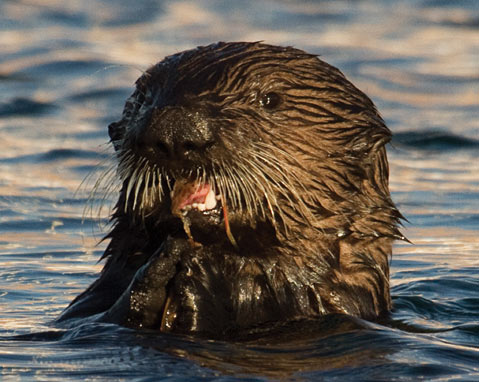
It’s a gloomy, gray July morning when I hop from the pier at Gaviota State Beach to board the tiny research vessel that’s been following sea otters as they swim south of Point Conception and take up residence in the Santa Barbara Channel for the first time in centuries. But by the time the steady static of the telemetry receiver is interrupted by rhythmic, telltale blips indicating our first radio-collared otter of the day, the skies are positively pea-soupy, dark swatches of bobbing seaweed the only demarcation between ocean and air.
“See those black specks out there?” asks Nicole LaRoche, a Chicago-raised UC Santa Cruz grad who studies otters for the United States Geological Survey (USGS) and sells her marine wildlife photographs at S.B.’s Sunday beach show. “Those are otters.”
As LaRoche pulls out handheld computers to record the otters, their locations, and, if visible, what they’re doing, I peer deeper into the mist as we skip through the sea somewhere off Cojo Anchorage, but the raft of furry beasts quickly disappears. “Oh, we spooked them all,” says LaRoche, who began following these otters in the spring of 2012 and will repeat this routine at least eight days a month until her study is done in March 2015. “We didn’t even slow down. They spook so easily.” As we steadily meander back toward Gaviota, the weather clears up a bit, but the otter spotting — complicated by the presence of harbor seals, thick clumps of kelp, and other look-alikes known in the tracking trade as “notters” — doesn’t get much easier, with some individuals identified only when they dive underwater and their beeping stops.
I didn’t realize it at the time, but, after a couple of months of chatting with scientists, fishermen, and others whose pasts, presents, and futures are intertwined with the fate of this mercurial marine mammal, such fleeting discoveries and sudden vanishings amid barely navigable fog perfectly mirror the four decades of work and worry involved in bringing the species back from the brink of extinction. Despite countless studies, millions of dollars, odd regulations, and lots of lawsuits, the otter population — which was declared “threatened” under the federal Endangered Species Act in 1977 — is not rebounding anywhere near as fast as was once hoped.
“My vision of the future was one in which the otter would have continued to increase at the rate it was doing then, about 4 to 5 percent a year, but in the mid-1990s, it stopped.”
“I thought when I first came to California in the late 1970s that, if I lived to this point, there would be a heck of a lot more otters than there are now,” explained Jim Estes, the 67-year-old former USGS researcher and current UC Santa Cruz professor who’s considered the godfather of otter studies. “My vision of the future was one in which the otter would have continued to increase at the rate it was doing then, about 4 to 5 percent a year, but in the mid-1990s, it stopped.”
Today, there are slightly more than 2,900 otters living off the California coast, which is actually less than were counted in 2007 and consistent with the stagnation of the past decade. It’s certainly a drastic increase from the colony of 50 found along Big Sur in 1938 when the species was believed to be extinct, but nowhere near the 16,000 thought to have been alive before fur traders nearly wiped them out. Now, instead of hunting, otters are being killed by a cornucopia of diseases — many triggered by onshore human activities — and ever more frequently by sharks, who seem to be mistaking the otters for seals as they do the occasional surfer. Underlying all this is the likelihood that otter populations may be nearing equilibrium with the Central Coast’s available food resources, stressing hungry animals enough that minor maladies become lethal. But these blips of understanding only shine momentary rays of light into a vast fog of unknowns, so the overall state of the southern sea otter remains very much a murky mystery.
“It’s interesting,” LaRoche admitted last week over the phone from the Santa Barbara Zoo, which is supporting her project with office space and volunteer trackers. “Sometimes the more we learn, the less we know.”
There does seem to be consensus on three things, at least from the prevailing scientific perspective: One, the otter is a “keystone” species, meaning that its presence as top predator has vast effects on nearshore habitats — both known, like healthier kelp forests and the fish species that come with them, and others still being discovered, like the recent report revealing how otters’ appetite for certain crabs is cleaning up Elkhorn Slough. Two, it’s a tremendous “sentinel” species, a coastal canary in the oceanic coal mine, revealing toxins that could also affect us humans. And three, if the species is going to reach a sustainable population, otters must expand their territory much farther north of Monterey Bay and far deeper into Southern California.
That puts LaRoche’s work at the forefront of otter survival, so everyone is watching to see what she learns about the furry explorers of our foggy fringe. “It should be natural for them to come back down to this area,” said LaRoche. “I think that would be good for them, but there could be other human consequences.”

Urgin’ for Urchin
The sun is shining and the weather is sweet on the August morning I leave the Santa Barbara Harbor aboard the Abreojos, the urchin diving boat owned and operated by Harry Liquornik, who was raised a surf rat on the Mesa and skipped college to start fishing commercially in the mid-1980s when he saw abalone boats return with longboards on their roofs. The longtime Westside resident sees his future, like the skies above us, as crystal clear when the voracious, four-foot beasts arrive in force: The urchin industry will be gone forever.
Liquornik and the dozens of other Santa Barbara urchin divers — many of whom already endured the end of the region’s abalone industry in the 1990s — suffered their first blows after the storms of ’97, when otters began exploring the waters off Point Conception. Before then, overnight trips to Hollister Ranch and Jalama Beach were yielding a million or so pounds of urchins a year; that same stretch of coastline only amounts to about 100,000 pounds today. Liquornik still heads up the coast for day trips to satisfy restaurant clients by hauling in small loads of “pieces,” as he calls the spiky invertebrates, which is what he does during a brief dive while I wait on deck, where we soon are slurping down the bright orange, salty-sweet roe.
But the bulk of his business is across the sea at the Channel Islands, a main refuge for the couple of hundred commercial urchin permit holders in Southern California. What happens when the otters figure that out? “It will be kind of ugly,” said Liquornik. “It will be painful.”
Steve Rebuck knows such pain personally. Today a house painter in San Luis Obispo, Rebuck grew up in Morro Bay, watching his father’s fishing business dwindle due to the resurgence of otters there in the 1960s and ’70s. “It was heartbreaking to watch all of our dads losing their businesses,” said Rebuck, who dove into the political squabble over what to do about otters in the early 1980s and never left. “They really damaged our economy and our well-being.”
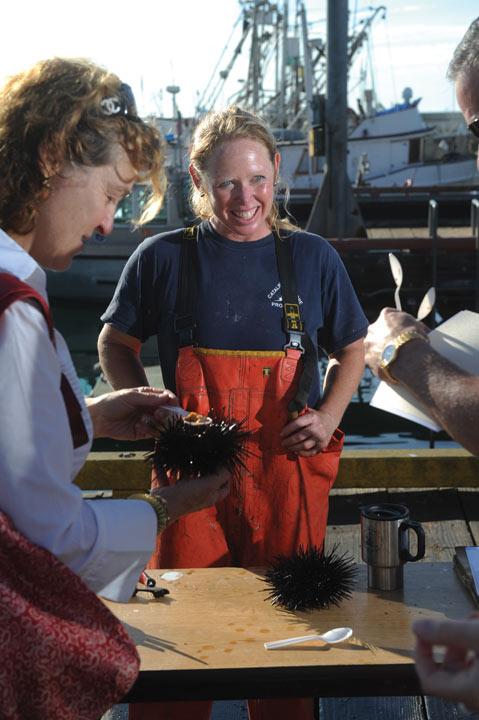
With otter populations currently growing at a snail’s pace, the sky won’t likely fall on urchin divers anytime too soon. But other fishermen, from lobster divers to those catching finned fish with nets and lines, also fear the coming of the otter, worrying that their presence will trigger further regulations on fishing techniques and potentially lead to prosecution if they accidentally hurt one. “If we have an accident, we don’t want to go to prison,” explained Stephanie Mutz, the red-headed urchin diver who heads up the Commercial Fishermen of Santa Barbara, which is now suing the feds to keep the existing fishermen safeguards in place. “The otters will go where they want, and we know you can’t control Mother Nature — all we want is some protection.”
In an industry where the bottom line routinely runs into some of the world’s more stringent regulations — combined with new no-fishing zones and other external pressures like the price of gas and shifting market prices — any change could spell disaster. “Santa Barbara is one of the strongest ports left,” explained longtime S.B. trawler Gary Burke, noting the diversity of the fleet but warning that further rules could throw any fishery out of business. “Everything else is just a skeleton.”
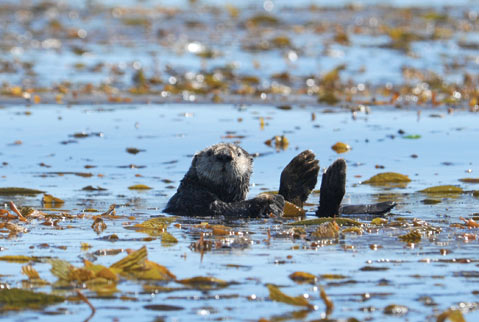
Maritime Madness
Until recently, Southern California fishermen didn’t have to worry, because a special law passed by Congress in 1987 stopped most federal regulations at Point Conception. Public Law 99-625 also moved some otters far south to San Nicolas Island in the event an oil spill wiped out the Central Coast population and, as a nod to the fishermen, created a “no-otter zone” south of Point Conception, where any otters who crossed the invisible line would be moved. Those two latter provisions never really happened: By 1991, all but a dozen of the 140 otters deposited at San Nic had swum back to the mainland or disappeared, and by 1993, due to both high expense and obvious futility, the U.S. Fish & Wildlife Service also stopped relocating the few that swam south of Point Conception.
“At certain times, it felt like The Flintstones, where you put the dinosaur out the front door and it comes in through the window,” said Fish & Wildlife otter coordinator Lilian Carswell, who has been working with the species’ recovery for more than a decade. “We saw that the plan wasn’t particularly workable.” Carswell believes it reflected an “earlier mindset,” when people were excessively worried about oil spills; when the interests of offshore oil companies, the military, and, to a lesser extent, fishermen influenced decision-making; and when scientists believed that otters would actually stay at San Nic.
“It’s one thing to say something and another thing to do it,” said Estes, who helped develop the law. “We had such a simplistic and short-sighted view of the whole problem that it was unrealistic. We’re dealing with that now.”
Public Law 99-625 is an easy target for the ire and conspiracy theories of fishermen, who say they were late to the negotiation table back in the early ’80s — they only got a seat due to a serendipitous tennis match in Louisiana between a diver and a congressmember, according to Rebuck — and, once involved, predicted the program’s stupidity but couldn’t do anything to stop it. “Frankly, we called it pretty accurately the way it devolved,” said Rebuck, who suspects that San Nic was a ploy to expand the species’ range, a theory growing riper every year as otters thrive better there now than anywhere, today numbering 59. Liquornik calls the otter pressure from both north and south “double jeopardy,” laughing, “They planned that one out perfectly.”
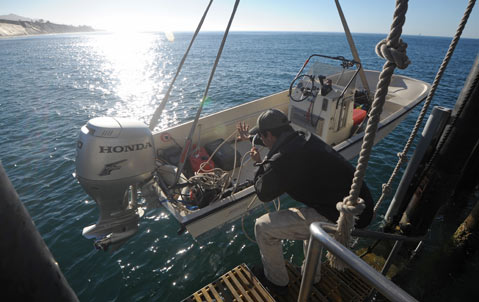
In retrospect, the law looks rather ridiculous, but Estes contends it was more about politics and wishful thinking than strategy. “There was some fairly weak decision-making that went on,” he said. “But I don’t know what else the Fish & Wildlife Service could have done. They were stuck with a really tough problem.”
The political pressure persisted into the early ’90s, when Fish & Wildlife first tried to declare the program a failure but ran into opposition from the California Department of Fish & Game, which was reluctant to undermine the fishing industry; the offshore oil industry, which saw the otter as a threat until the drilling moratorium in 1994; and the U.S. Navy, which feared otter impact on its San Nic war games. The status quo, in which otters were left to their own devices but fishermen and others retained a regulation-free zone south of Point Conception, persisted for decades. Then, in 2009, a lawsuit was filed on behalf of The Otter Project by the Santa Barbara–based Environmental Defense Center (EDC), demanding that Fish & Wildlife finalize the failure determination, terminate the “no-otter zone,” and extend federal protections to Southern California waters.
The EDC prevailed, and last December, Fish & Wildlife declared Public Law 99-625 dead, officially ending both translocation and the no-otter zone — neither of which were active for 20 years — but also, for the first time, increasing the otter’s Endangered Species Act protections to SoCal waters. Fishing groups immediately threatened to sue and did so in July, when the Pacific Legal Foundation — on behalf of the Commercial Fishermen of Santa Barbara, the California Sea Urchin Commission, the California Abalone Association, and the California Lobster and Trap Fishermen’s Association — filed suit, arguing that Fish & Wildlife can’t end a program that Congress created. The first hearing is September 13, when a judge will decide whether the EDC, The Otter Project, and the Friends of the Sea Otter can help defend the federal government as interveners.
Most view the lawsuit as merely stalling the inevitable extension of otter protections everywhere, but fishermen are trying hard to inform the public of what that may mean while dreaming about a compromise that would incorporate their needs. “We want awareness that, as they move south, shellfisheries in this region will be eliminated,” lobster diver Chris Voss explained amid the Santa Barbara Fishermen’s Market, where people buy urchins, crabs, black cod, and other fish straight from the fishermen. “And if that’s the case, maybe we want to balance human use and otter use. There must be some way.”
Such a way remains unclear. The vague fisherman refrain of “ecosystem management,” which they interpret as protecting fisheries and otters, sounds a lot like the otter relocation idea that already failed and reflects an older era when economics more easily trumped nature. The only concrete methods came from Sue Bennett, who’s been studying otters since 1973 but doesn’t have the recovery-at-all-costs bent of most scientists and advocates. She suggests allowing fishermen to harass otters in selected zones until they learn to stay away and, at the fringes of the range, culling, which is to say killing, the males. But she readily admits such ideas would have a hard time getting approved, given the current mindset of nature first, humans second. She explained, “Maybe it’s time to think outside of the box, look at what’s really happening here, and say, ‘If there were no rules or regulations, how would you handle this?’”
No one denies that otters may one day end the regional urchin business, but Fish & Wildlife’s Carswell feels many fishing concerns are overblown, particularly since the species are expanding so slowly. “It’s a pretty gradual process,” she said. “And no one’s ever been prosecuted for taking an otter.”
Perhaps more to the point, though, is that rules regarding otters aren’t going away, even when they achieve a stable population of 3,090 individuals and come off the Endangered Species Act. That will only trigger a new round of regulations under the Marine Mammal Protection Act, which aims to bring the population past 8,000 animals. “Really,” said Carswell, “people should get used to protected status for sea otters.”
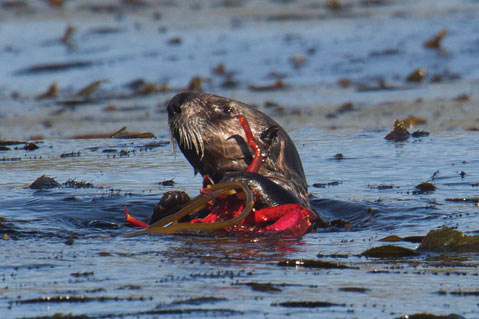
Savaged Beast
The only thing more puzzling than the laws surrounding the southern sea otter is how the species even made it this far. A member of the otherwise terrestrial weasel family, otters are definitely in the running for most poorly designed marine mammal: Rather than having blubber to stay warm, otters have thick, felt-like fur that requires constant combing to keep air bubbles in and water out; because that only works so well, they also run very hot and have a high metabolism, requiring a steady diet of shellfish, crabs, and other invertebrates; and instead of a sleek, dolphinesque shape, otters have a lumpy, inefficient frame.
They’ve evolved into a very limited niche, a thin stretch of habitat from the shoreline out to about 100 feet deep, and don’t tend to stray too far from home, save for juvenile males looking for new digs. Their family life is dysfunctional, with males frequently robbing the females or holding pups hostage for food, and their sex life is vicious, as males basically rape females by ripping their noses to shreds and then force them to do it all over again a year later when the moms are weak and worn down from months of nursing their pups.
“Even in perfect circumstances,” said Mike Murray, who is the Monterey Bay Aquarium’s veterinarian and deals with all of the state’s captured otters, “they’re living on the edge.”
But circumstances have been far from perfect, even prior to the surge of shark attacks. Because they cling to the coast and have to deal with civilization’s shit, both literally and figuratively, otters wind up with a laundry list of illnesses. There are brain-infecting parasites that come from swimming amid cat, possum, and raccoon poop, stomach-destroying worms that come from eating sand crabs, and various bacterial and fungal infections, including valley fever. They get sick from chemicals used by farms, harbors, and sewage plants, can suffer from domoic-acid poisoning when ocean algae blooms, and are also the first known ocean species to be killed by freshwater cyanotoxins, which no one ever thought could enter the marine ecosystem until 11 otters died in 2007 when their livers turned to mush.
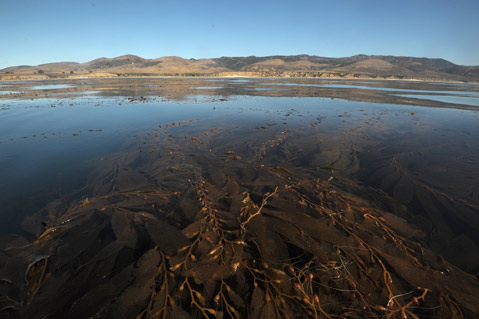
The latter groundbreaking discovery was just the latest example of how onshore human activities affect otters, but they all reveal how our destruction of natural water filters like native vegetation and wetlands in favor of parking lots and concrete creeks are opening the floodgates for disease. “I’ve never seen anything like the sea otter as a sentinel species,” said Melissa Miller, the California Department of Fish & Wildlife (formerly Fish & Game) vet who examines dead otters and made the cyanotoxin connection. “They are so good at indicating problems that they can even point to specific watersheds.” The 11 dead otters of 2007, for instance, pointed to Pinto Lake in Watsonville, and the Monterey Bay community is now working to clean it up.
Fishermen list off these problems as evidence that otters can never be saved — “We’re sacrificing all of these valuable resources for an animal who might not make it anyhow,” said Rebuck — but there’s possibly something else going on entirely: The Central Coast–residing otters may be reaching what’s known as “carrying capacity,” the maximum number of animals that the habitat can naturally sustain. “If you look from Monterey Bay to Morro Bay, there’s no reason to believe that the densities we have are any different than the densities they were prior to the fur trade,” said Tim Tinker, who began championing this theory after he took over otter research at USGS when Jim Estes left in 2008. “They are being supported at equilibrium, with densities as high as anywhere in the North Pacific.”
Balance certainly sounds peaceful, but just enough food really means struggle for survival. Starving otters can have compromised immune systems, so otherwise minor and even normal bacteria, parasites, toxins, and pollutants can kill. Combine that with a skinny mother otter that’s been nursing for months, then gets her nose torn apart during her annual rape, and then is pregnant again, and you understand why the scientists are having to come up with names like “end-lactation syndrome” to explain the many deaths. “This spiral just accelerates down,” said Murray, the aquarium vet, who said he’s “drank the Kool-Aid” of Tinker’s carrying-capacity argument. “When you limit their food, pathogens, pollutants, and those kinds of impacts become even more profound.”
Also imbibing Tinker’s Kool-Aid is his mentor, Estes, one of the first to notice decades ago that otter numbers were suffering from early deaths, or mortality, rather than low reproduction rates, or fecundity. “I think we had it all wrong,” said Estes. “It is mortality, but the evidence really points to an idea that’s pretty different.” Because of California’s relatively linear coastal geography, the offspring of otters in regions that have reached carrying capacity cannot swim far enough away to the north or south to establish new colonies and grow the overall numbers. Meanwhile, otter numbers are booming in Alaska and British Columbia, where islands and multidimensional coastlines keep populations soaring.
“Ultimately what drives range expansion is population growth,” said Tinker. “If populations at the center stop growing, there is no force for diffusion outward. Range expansion will grind to a halt.”
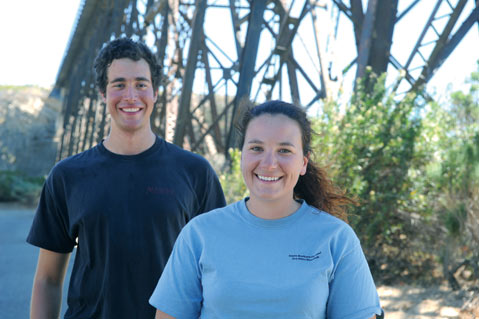
spend eight or more days a month checking on the otters that live off of the Gaviota Coast and Hollister Ranch and Point Conception. “For otters in California to extend their population numbers,” said LaRoche, “they need to expand their range, and it’s either gonna be north or south.”
Back on the Boat
That brings us back to Nicole LaRoche’s Santa Barbara Channel study, which isn’t even half done but is already revealing what life is like in a less-crowded place: Our otters tend to be bigger, healthier, and travel more, particularly some of the males, which one day might be at Gaviota State Beach, the next up at Jalama. But the unknowns are piling up too: The otters are seasonal, with about 100 here in the winter but only about 50 in the summer, and they gather in groups randomly, like the 30 that came together for a few months off Coal Oil Point four years ago only to disperse and never return. LaRoche still has no clue on whether natural oil seepage poses any harm, which is the question that prompted the offshore-oil industry to pay for her study through a Bureau of Ocean Energy Management grant.
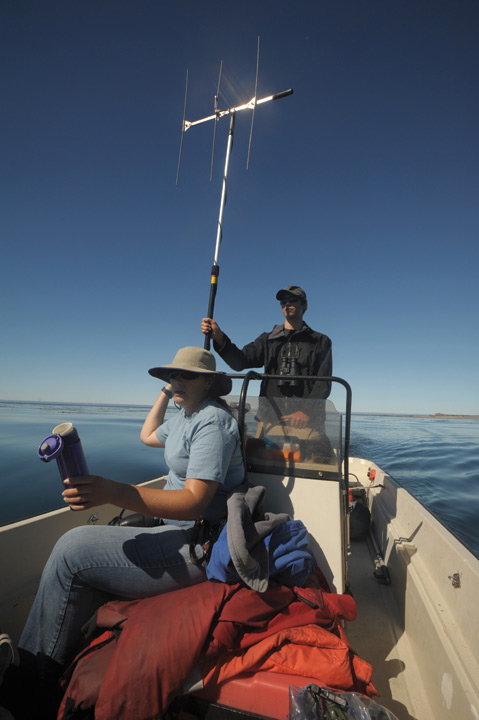
LaRoche thinks that, compared to the rocky shores of the Central Coast, Southern California’s sandy bottom shores may be a limiting factor, but she’s seen them eat enough bright red crabs to know food is plentiful. As for the fishermen, whom LaRoche motors past every research day on the water, she’s sympathetic but doesn’t have any answers. “I understand that people are part of the environment, but we take ourselves to be this higher being than all other animals,” she said. “We should fix the environment to the most pristine we can make it and then work around that for our own needs.”
After four decades of ups and downs, the otter godfather remains hopeful — though, as experience suggests, there are caveats. “I’d be a hell of a lot more concerned about pandas or tigers than I am about otters going extinct,” said Estes, who’s currently writing a book about his life among them. “On the other hand, there will be many conflicts between people and otters in the future. It’s a really interesting case of whether people can live in harmony with a predator. I think the jury is still out on that.”
Sea Otter Awareness Week
As part of the September 22-28 international event, Nicole LaRoche and Greg Sanders will answer questions about the species after a screening of the film Threatened on Monday, September 23, 7 p.m., at the Santa Barbara Maritime Museum. Suggested donation is $5.
See seaotterweek.org.



